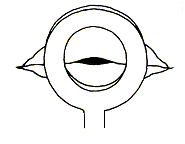Introduction
Excessive Pressure
Bunched Chin
Smile Embouchure
Lip Protrusion
Orthodontic Braces
This section takes a look at a few of the more common embouchure faults and suggests ways to correct them. The discussion, however, is not meant to be comprehensive. Inevitably, band directors will need to make analyses of embouchure problems themselves and engage in a good deal of experimentation in order to find a solution. This is not as forbidding as it sounds. Most embouchure problems can be identified by careful reference to the standard embouchure described in the section on the player. As for solutions, they often amount to little more than commonsense procedures.

Yet another – more recent – invention is the transparent mouthpiece. This enables the embouchure to be observed in action. Unfortunately, even well stocked retailers rarely sell such products in Asia. The resourceful band director, however, can have a substitute visualizer manufactured almost anywhere by supplying a local machine shop with an old mouthpiece.
This is perhaps the most common embouchure fault found among young players. It is certainly the one that is most well known. The problem usually develops early on when the performer, anxious to hit a note he or she finds particularly high, discovers that increasing mouthpiece pressure seems to produce the desired result. The short-term advantage, however, is more than outweighed by the long-term damage. Excessive pressure adversely affects tone quality, flexibility and even range.
Heavy mouthpiece pressure restricts the flow of blood to the lips, causing them to tire quickly. Moreover, players who employ excessive pressure will not improve their endurance no matter how frequently they practice. This is because the muscles at the corners of the lips (which determine lip tension in good embouchures) are hardly being used at all and therefore do not get the opportunity to experience a good workout.
Band directors can also become the source of the problem by pushing students to play in the high register too soon, or simply trying to scare the notes out of the players by making threats. Comments such as “I don’t care how you do it, but play that high C properly at the concert or you will shame the band and the entire school” are potentially very destructive because they encourage a student to tense up.
Symptoms of excessive lip pressure include the following:
|
|
|
|
|
|
|
Once the habit of using too much pressure has been formed it can be a difficult one to break. Even so, it can be done provided the student is sufficiently determined. I have found the following to be particularly helpful:
|
|
|
|
|
In the case of a good embouchure, the chin remains flat or arched down. Some students, however, thrust their chins upward instead, creating a bunched chin. This can affect flexibility and cause upper register notes to sound thin. The following can help resolve the problem:
|
|
|
Once regarded as a legitimate means of sound production for brass instruments, the smile embouchure has few adherents these days. This is because the stretched lips tend to produce a thin, hard tone. Endurance also suffers. Such an embouchure places the chin muscles in a relaxed state. The tissue inside the mouthpiece, however, becomes tense and the lip aperture tends to close, thus reducing control and flexibility. In resolving the problem, the trick is to find the proper balance between the smile and pucker.
|
|
|
In this case the student adopts an excessively puckered embouchure such that the lips tend to sag into the mouthpiece. The resulting widening of the lip aperture produces a thick, airy sound that is without resonance. The suggested solution is almost the opposite of that recommended for the smile embouchure:
|
|
|
A word of warning. Take care not to pull the lips back over the teeth like an oboe player. This will result in even more serious embouchure problems.
A brass player undergoing orthodontic therapy often has brackets and wires attached to his teeth that can seriously impair his ability to play properly. Orthodontic appliances disturb the delicate balance of the embouchure by changing the contours of the hard structures over which the soft muscle tissues lie. Playing often causes pain in the high register – particularly for trumpet players -- when mouthpiece pressure increases. Forced to concentrate on adjusting his embouchure, the young trumpeter tends to neglect other aspects of performance such as breath support. As a result, tone production suffers along with range and flexibility. In my experience, the lips of such players are often found to be protruding into the mouthpiece as well, producing the airy sound described earlier. Because such braces tend to dig into the soft flesh of the lips, players try to avoid the resulting discomfort by relaxing their cheek muscles. In such cases, removing the braces would obviously be the best solution.
No mouthpiece has yet been devised that will eliminate the pain of playing with braces. Vincent Bach has pointed out that any mouthpiece radical enough in design to minimize the problem also tends to inhibit the development of important technical skills. His advice to a young person facing the problem is that it is “better to concentrate for two or three years on aspects of technique that require minimum lip pressure than to develop habits that may never be corrected" [Vincent Bach "The Search for the Perfect Mouthpiece" in Embouchure and Mouthpiece Manual, The Selmer Company, Elkhar, Indiana, 1979 page 11].












